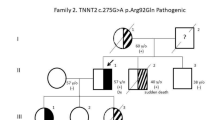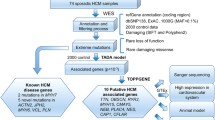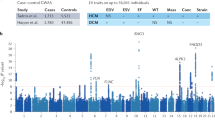Abstract
Hypertrophic cardiomyopathy (HCM) is a common genetic disease, predominantly caused by mutations in cardiac sarcomere genes; however, whether MYH7B causes HCM is not known. In this study, 549 unrelated patients with HCM and 500 healthy-controls were screened using targeted sequencing and whole exome sequencing together. We observed seven variants in MYH7B causing HCM in 8/549 patients, which accounted for 1.46% of HCM cases. Of these seven variants, three likely pathogenic variants in MYH7B co-segregating with 5 HCM patients were identified in three HCM pedigrees without other HCM-associated variants. Myh7b knockout rats were generated and cardiac functions were detected by Millar pressure-volume catheterization and echocardiography. Spontaneous HCM phenotypes, cellular disarray and cardiac fibrosis were observed in both Myh7b+/−/Myh7b−/− rats. Transcriptome sequencing showed that calcium is the key mediator of cardiac hypertrophy in Myh7b knockout. Subsequent analysis confirmed over-activation of CaMK-signaling pathway in cardiomyocytes of Myh7b−/− rats. Furthermore, MYH7B expression in human and rat hearts was identified and microRNA-208a and microRNA-499 levels are unchanged in HCM patients and Myh7b+/−/Myh7b−/− rats. This study is the first to identifyMYH7B variants as cause of HCM, which account for 1.46% of pathogenesisin HCM patients. Activation of CaMK-signaling pathway may be involved in its pathophysiology.
Similar content being viewed by others
Change history
21 October 2021
An Erratum to this paper has been published: https://doi.org/10.1007/s11427-021-1995-6
References
Alfares, A.A., Kelly, M.A., McDermott, G., Funke, B.H., Lebo, M.S., Baxter, S.B., Shen, J., McLaughlin, H.M., Clark, E.H., Babb, L.J., et al. (2015). Results of clinical genetic testing of 2,912 probands with hypertrophic cardiomyopathy: expanded panels offer limited additional sensitivity. Genet Med 17, 880–888.
Black, B.L., and Olson, E.N. (1998). Transcriptional control of muscle development by myocyte enhancer factor-2 (MEF2) proteins. Annu Rev Cell Dev Biol 14, 167–196.
Braun, A.P., and Schulman, H. (1995). The multifunctional calcium/calmodulin-dependent protein kinase: from form to function. Annu Rev Physiol 57, 417–445.
Brito, D., Miltenberger-Miltenyi, G., Vale Pereira, S., Silva, D., Diogo, A. N., and Madeira, H. (2012). Sarcomeric hypertrophic cardiomyopathy: genetic profile in a Portuguese population. Rev Port Cardiol 31, 577–587.
Cingolani, H.E., and Ennis, I.L. (2007). Sodium-hydrogen exchanger, cardiac overload, and myocardial hypertrophy. Circulation 115, 1090–1100.
Cingolani, O.H., Yang, X.P., Cavasin, M.A., and Carretero, O.A. (2003). Increased systolic performance with diastolic dysfunction in adult spontaneously hypertensive rats. Hypertension 41, 249–254.
Cui, G., Li, Z., Li, R., Huang, J., Wang, H., Zhang, L., Ding, H., and Wang, D.W. (2014). A functional variant in APOA5/A4/C3/A1 gene cluster contributes to elevated triglycerides and severity of CAD by interfering with microRNA 3201 binding efficiency. J Am Coll Cardiol 64, 267–277.
Desjardins, C.A., and Naya, F.J. (2016). The function of the MEF2 family of transcription factors in cardiac development, cardiogenomics, and direct reprogramming. J Cardiovasc Dev Dis 3, 26.
Desjardins, P.R., Burkman, J.M., Shrager, J.B., Allmond, L.A., and Stedman, H.H. (2002). Evolutionary implications of three novel members of the human sarcomeric myosin heavy chain gene family. Mol Biol Evol 19, 375–393.
Elliott, P.M., Anastasakis, A., Borger, M.A., Borggrefe, M., Cecchi, F., Charron, P., Hagege, A.A., Lafont, A., Limongelli, G., Mahrholdt, H., et al. (2014). 2014 ESC Guidelines on diagnosis and management of hypertrophic cardiomyopathy. Eur Heart J 35, 2733–2779.
Esposito, T., Sampaolo, S., Limongelli, G., Varone, A., Formicola, D., Diodato, D., Farina, O., Napolitano, F., Pacileo, G., Gianfrancesco, F., et al. (2013). Digenic mutational inheritance of the integrin alpha 7 and the myosin heavy chain 7B genes causes congenital myopathy with left ventricular non-compact cardiomyopathy. Orphanet J Rare Dis 8, 91.
Fan, J., Zhang, X., Nie, X., Li, H., Yuan, S., Dai, B., Zhan, J., Wen, Z., Jiang, J., Chen, C., et al. (2019). Nuclear miR-665 aggravates heart failure via suppressing phosphatase and tensin homolog transcription. Sci China Life Sci https://doi.org/10.1007/s11427-018-9515-1.
Foster, F.S., Mehi, J., Lukacs, M., Hirson, D., White, C., Chaggares, C., and Needles, A. (2009). A new 15–50 MHz array-based micro-ultrasound scanner for preclinical imaging. Ultrasound Med Biol 35, 1700–1708.
Frey, N., McKinsey, T.A., and Olson, E.N. (2000). Decoding calcium signals involved in cardiac growth and function. Nat Med 6, 1221–1227.
Gersh, B.J., Maron, B.J., Bonow, R.O., Dearani, J.A., Fifer, M.A., Link, M. S., Naidu, S.S., Nishimura, R.A., Ommen, S.R., Rakowski, H., et al. (2011). 2011 ACCF/AHA guideline for the diagnosis and treatment of hypertrophic cardiomyopathy: executive summary. J Am Coll Cardiol 58, 2703–2738.
Gomes, A.V., Potter, J.D., and Szczesna-Cordary, D. (2002). The role of troponins in muscle contraction. IUBMB Life (Int Union Biochem Mol Biol Life) 54, 323–333.
Hook, S.S., and Means, A.R. (2001). Ca2+/CaM-DEPENDENT KINASES: From activation to function. Annu Rev Pharmacol Toxicol 41, 471–505.
Kassem, H.S., Azer, R.S., Saber-Ayad, M., Ayad, M.S., Moharem-Elgamal, S., Magdy, G., Elguindy, A., Cecchi, F., Olivotto, I., and Yacoub, M.H. (2013). Early results of sarcomeric gene screening from the Egyptian National BA-HCM Program. J Cardiovasc Trans Res 6, 65–80.
Li, B., and Leal, S.M. (2008). Methods for detecting associations with rare variants for common diseases: application to analysis of sequence data. Am J Hum Genet 83, 311–321.
Li, G.R., Lau, C.P., and Shrier, A. (2002). Heterogeneity of sodium current in atrial vs epicardial ventricular myocytes of adult guinea pig hearts. J Mol Cell Cardiol 34, 1185–1194.
Li, H., Zhang, X., Wang, F., Zhou, L., Yin, Z., Fan, J., Nie, X., Wang, P., Fu, X.D., Chen, C., et al. (2016). MicroRNA-21 lowers blood pressure in spontaneous hypertensive rats by upregulating mitochondrial translation. Circulation 134, 734–751.
Li, Z., Huang, J., Zhao, J., Chen, C., Wang, H., Ding, H., Wang, D.W., and Wang, D.W. (2014). Rapid molecular genetic diagnosis of hypertrophic cardiomyopathy by semiconductor sequencing. J Transl Med 12, 173.
Lopes, L.R., Zekavati, A., Syrris, P., Hubank, M., Giambartolomei, C., Dalageorgou, C., Jenkins, S., McKenna, W., Plagnol, V., and Elliott, P. M. (2013). Genetic complexity in hypertrophic cardiomyopathy revealed by high-throughput sequencing. J Med Genet 50, 228–239.
Lu, J., McKinsey, T.A., Nicol, R.L., and Olson, E.N. (2000). Signal-dependent activation of the MEF2 transcription factor by dissociation from histone deacetylases. Proc Natl Acad Sci USA 97, 4070–4075.
Mahdavi, V., Periasamy, M., and Nadal-Ginard, B. (1982). Molecular characterization of two myosin heavy chain genes expressed in the adult heart. Nature 297, 659–664.
Maier, L.S., and Bers, D.M. (2002). Calcium, calmodulin, and calcium-calmodulin kinase II: heartbeat to heartbeat and beyond. J Mol Cell Cardiol 34, 919–939.
Maron, B.J., Doerer, J.J., Haas, T.S., Tierney, D.M., and Mueller, F.O. (2009). Sudden deaths in young competitive athletes. Circulation 119, 1085–1092.
Maron, B.J., Epstein, S.E., and Roberts, W.C. (1986). Causes of sudden death in competitive athletes. J Am Coll Cardiol 7, 204–214.
Maron, B.J., McKenna, W.J., Danielson, G.K., Kappenberger, L.J., Kuhn, H.J., Seidman, C.E., Shah, P.M., Spencer Iii, W.H., Spirito, P., Ten Cate, F.J., et al. (2003). American College of Cardiology/European Society of Cardiology clinical expert consensus document on hypertrophic cardiomyopathy. J Am Coll Cardiol 42, 1687–1713.
Matthijs, G., Souche, E., Alders, M., Corveleyn, A., Eck, S., Feenstra, I., Race, V., Sistermans, E., Sturm, M., Weiss, M., et al. (2016). Guidelines for diagnostic next-generation sequencing. Eur J Hum Genet 24, 2–5.
McKinsey, T.A., Zhang, C.L., Lu, J., and Olson, E.N. (2000a). Signal-dependent nuclear export of a histone deacetylase regulates muscle differentiation. Nature 408, 106–111.
McKinsey, T.A., Zhang, C.L., and Olson, E.N. (2000b). Activation of the myocyte enhancer factor-2 transcription factor by calcium/calmodulin-dependent protein kinase-stimulated binding of 14-3-3 to histone deacetylase 5. Proc Natl Acad Sci USA 97, 14400–14405.
McKinsey, T.A., Zhang, C.L., and Olson, E.N. (2002). MEF2: a calcium-dependent regulator of cell division, differentiation and death. Trends Biochem Sci 27, 40–47.
Mora, R., Merino, J.L., Peinado, R., Olias, F., García-Guereta, L., del Cerro, M.J., Tarín, M.N., and Molano, J. (2006). Hypertrophic cardiomyopathy: infrequent mutation of the cardiac beta-myosin heavy-chain gene (in Spanish). Rev Esp Cardiol 59, 846–849.
Morita, H., Rehm, H.L., Menesses, A., McDonough, B., Roberts, A.E., Kucherlapati, R., Towbin, J.A., Seidman, J.G., and Seidman, C.E. (2008). Shared genetic causes of cardiac hypertrophy in children and adults. N Engl J Med 358, 1899–1908.
Morkin, E. (2000). Control of cardiac myosin heavy chain gene expression. Microsc Res Tech 50, 522–531.
Peter, A.K., Rossi, A.C., Buvoli, M., Ozeroff, C.D., Crocini, C., Perry, A. R., Buvoli, A.E., Lee, L.A., and Leinwand, L.A. (2019). Expression of normally repressed myosin heavy chain 7b in the mammalian heart induces dilated cardiomyopathy. J Am Heart Assoc 8, e013318.
Potthoff, M.J., and Olson, E.N. (2007). MEF2: a central regulator of diverse developmental programs. Development 134, 4131–4140.
Richards, S., Aziz, N., Bale, S., Bick, D., Das, S., Gastier-Foster, J., Grody, W.W., Hegde, M., Lyon, E., Spector, E., et al. (2015). Standards and guidelines for the interpretation of sequence variants: a joint consensus recommendation of the American College of Medical Genetics and Genomics and the Association for Molecular Pathology. Genet Med 17, 405–423.
Shieh, J.T.C., Huang, Y., Gilmore, J., and Srivastava, D. (2011). Elevated miR-499 levels blunt the cardiac stress response. PLoS ONE 6, e19481.
Suárez-Pantaleón, C., Huet, A.C., Kavanagh, O., Lei, H., Dervilly-Pinel, G., Le Bizec, B., Situ, C., and Delahaut, P. (2013). Production of polyclonal antibodies directed to recombinant methionyl bovine somatotropin. Anal Chim Acta 761, 186–193.
Van Driest, S.L., Ommen, S.R., Tajik, A.J., Gersh, B.J., and Ackerman, M. J. (2005). Yield of genetic testing in hypertrophic cardiomyopathy. Mayo Clinic Proc 80, 739–744.
van Rooij, E., Quiat, D., Johnson, B.A., Sutherland, L.B., Qi, X., Richardson, J.A., Kelm Jr., R.J., and Olson, E.N. (2009). A family of microRNAs encoded by myosin genes governs myosin expression and muscle performance. Dev Cell 17, 662–673.
Walsh, R., Buchan, R., Wilk, A., John, S., Felkin, L.E., Thomson, K.L., Chiaw, T.H., Loong, C.C.W., Pua, C.J., Raphael, C., et al. (2017). Defining the genetic architecture of hypertrophic cardiomyopathy: re-evaluating the role of non-sarcomeric genes. Eur Heart J 38, 3461–3468.
Warkman, A.S., Whitman, S.A., Miller, M.K., Garriock, R.J., Schwach, C. M., Gregorio, C.C., and Krieg, P.A. (2012). Developmental expression and cardiac transcriptional regulation of Myh7b, a third myosin heavy chain in the vertebrate heart. Cytoskeleton 69, 324–335.
Watkins, H., Ashrafian, H., and Redwood, C. (2011). Inherited cardiomyopathies. N Engl J Med 364, 1643–1656.
Wehbe, N., Nasser, S.A., Pintus, G., Badran, A., Eid, A.H., and Baydoun, E. (2019). MicroRNAs in cardiac hypertrophy. Int J Med Sci 20, 4714.
Zhang, C.L., McKinsey, T.A., and Olson, E.N. (2001). The transcriptional corepressor MITR is a signal-responsive inhibitor of myogenesis. Proc Natl Acad Sci USA 98, 7354–7359.
Zhang, T., and Brown, J.H. (2004). Role of Ca2+/calmodulin-dependent protein kinase II in cardiac hypertrophy and heart failure. Cardiovasc Res 63, 476–486.
Zhao, J., Yao, H., Li, Z., Wang, L., Liu, G., Wang, D.W., Wang, D.W., and Liang, Z. (2016). A novel nonsense mutation in LMNA gene identified by Exome Sequencing in an atrial fibrillation family. Eur J Med Genet 59, 396–400.
Acknowledgements
The authors are grateful for all the participants in this study and thank Dr. Chenze Li for statistical analysis. This work was supported by the National Natural Science Foundation of China (81700413, 81630010, 91439203, 91839302), National Key Research and Development Project-Precision Medicine (2017YFC0909401), and Fundamental Research Funds for the Central Universities (No. 2015ZDTD044).
Author information
Authors and Affiliations
Corresponding author
Additional information
Compliance and ethics
The author(s) declare that they have no conflict of interest.
Electronic supplementary material
Rights and permissions
About this article
Cite this article
Chen, P., Li, Z., Nie, J. et al. MYH7B variants cause hypertrophic cardiomyopathy by activating the CaMK-signaling pathway. Sci. China Life Sci. 63, 1347–1362 (2020). https://doi.org/10.1007/s11427-019-1627-y
Received:
Accepted:
Published:
Issue Date:
DOI: https://doi.org/10.1007/s11427-019-1627-y




